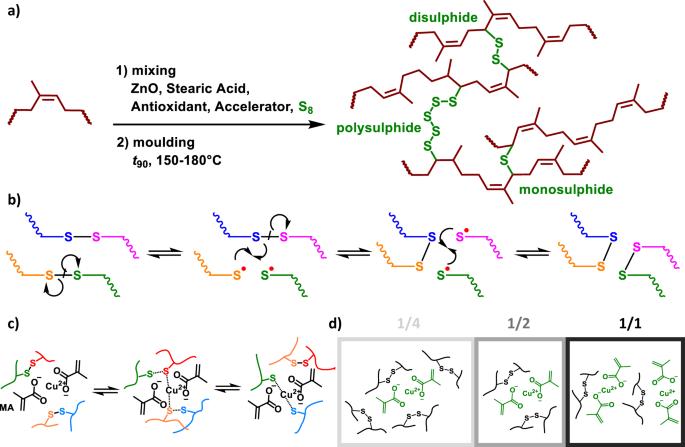可回收硫磺硫化天然橡胶与受控二硫化物的偏析反应
IF 9.6
Q1 MATERIALS SCIENCE, MULTIDISCIPLINARY
引用次数: 0
摘要
传统上,硫硫化天然橡胶化合物的可回收性有限,原因是再加工后机械性能显著下降。交联聚合物在回收后仍能保持物理和化学特性,是全球橡胶工业实现可持续发展的基本要求。在此,我们证明了调整硫化工艺,使其有利于基于二硫键和多硫键的可逆交联网络,从而实现可回收性。我们使用硫基硫化体系,优化甲基丙烯酸铜 (II),浓度分别为 2.47、4.94 和 9.89 phr,以控制二硫化物在低温下的偏析,提高可回收性。机械特性分析表明,2.47 phr 的浓度最适合在初次成型后保持机械特性,并在回收后完全恢复机械特性。此外,我们还证明了甲基丙烯酸铜 (II) 可融入现有的橡胶废料流中,以提高可回收性。交联聚合物在回收后必须保持物理和化学特性,以提高可持续性。在此,我们调整了固化过程,以便利用二硫键和多硫键形成可逆交联网络,从而保持机械性能。本文章由计算机程序翻译,如有差异,请以英文原文为准。

Recyclable sulfur cured natural rubber with controlled disulfide metathesis
Traditionally, sulfur-cured natural rubber compounds exhibit limited recyclability due to a significant drop in mechanical performance after reprocessing. Maintaining physical and chemical properties after recycling of a cross-linked polymer is an essential requirement for the global rubber industry to become more sustainable. Here, we demonstrate that tuning the curing process to favour a reversible cross-linked network based on disulfide and polysulfide bonds enables recyclability. We use a sulfur-based vulcanization system optimized with copper (II) methacrylate at concentrations of 2.47, 4.94, and 9.89 phr to control disulfide metathesis at low temperatures and enhance recyclability. Mechanical characterization identifies 2.47 phr as optimal for maintaining mechanical properties after initial moulding and full recovery after recycling. Additionally, we demonstrate that copper (II) methacrylate can be incorporated into existing rubber waste streams to promote recyclability. Cross-linked polymers must maintain physical and chemical properties after recycling to improve sustainability. Here, tuning the curing process to favour a reversible cross-linked network using disulfides and polysulfides bonds retains mechanical performance.
求助全文
通过发布文献求助,成功后即可免费获取论文全文。
去求助
来源期刊

Communications Materials
MATERIALS SCIENCE, MULTIDISCIPLINARY-
CiteScore
12.10
自引率
1.30%
发文量
85
审稿时长
17 weeks
期刊介绍:
Communications Materials, a selective open access journal within Nature Portfolio, is dedicated to publishing top-tier research, reviews, and commentary across all facets of materials science. The journal showcases significant advancements in specialized research areas, encompassing both fundamental and applied studies. Serving as an open access option for materials sciences, Communications Materials applies less stringent criteria for impact and significance compared to Nature-branded journals, including Nature Communications.
 求助内容:
求助内容: 应助结果提醒方式:
应助结果提醒方式:


